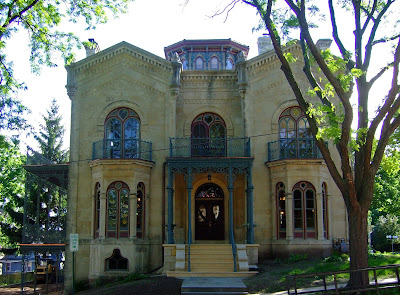 |
| The George W. Loomis House, Suffield, CT. 1860 |
The George W. Loomis house is the second of the Loomis houses I will be exploring. The house was built by one of the Loomis brothers for their son; in 1912 it became the rectory for St. Joseph's Church next door. The house follows the symmetrical plan with a hip roof and cupola. Despite being sided with what appears to be aluminum, the house preserves many of its fine features. Like the Byron Loomis house, this house also features a central two story porch, but this porch has a much more flamboyant treatment. The first stage is simple enough, with fluted columns, but there is no crowning cornice here. The columns rise to the second stage where they flare out with four pieced curving pieces that stick out on each side, looking like some gnarled tree trunk. The second story is crowned by a jigsawed ogee and wide eave. Because there is no intervening cornice line between the porch's two stages, the effect produced is of the first stage being the column and the second stage being the elongated almost Moorish capital. Other Italianates with Moorish treatments do this with their porches, and it might be the influence of Henry Austin's Indian style of ornament. Adding to the odd effect is the iron cresting that caps the wooden balustrade on the second stage of the porch.
The cornice is surprisingly large on this house, and the brackets are correspondingly elongated with finials that suggest the icicle effect of some Italianates. The windows in the frieze are segmentally arched, as are the windows on the first story at the front, but are currently serving as vents. Over the windows on the front façade on the second floor hang exterior lambrequins. These are wooden cut out pieces, in this case representing arches, that are applied to a rectangular window to alter its shape.
Another unique feature of this house is that two of the panes on the front of the cupola are stained, blue and orange respectively. This treatment is probably part of the original scheme in which all the windows of the cupola featured glass of different colors. It's impressive that these two pieces survive! The house has a dramatic siting on a small hill set back quite far from the main road. This gives the house a very commanding presence on the street and increases its visibility. The George Loomis house is calculated to create a grand and exotic effect which not even its current state of poor restoration can dim.





































.jpg)

.jpg)
.jpg)
.jpg)











